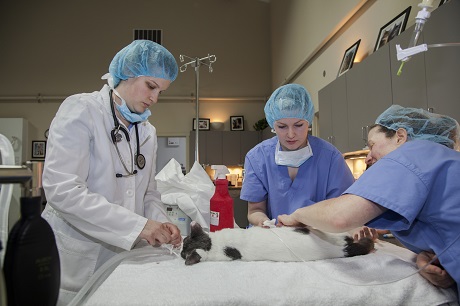All About the Animals
Veterinary Technician program launches its next cohort in September 2020; potential candidates are encouraged to begin prerequisites this fall
The unrelenting beat of “Staying Alive” blares from a smartphone as four students
of Central Oregon Community College’s Veterinary Technician program, in blue scrubs
and stethoscopes, prepare to begin a cardiac arrest drill. While serving as the standard
beat-for-beat metronome in CPR training, the Bee Gees’ catchy tune also has a way
of spiking energy levels. Adrenaline is running high—and so are hopes.
“I’m starting CPR!” a first-year student called out as she stepped up on a footstool
in the mock emergency room, stacked her hands together, and began applying strong
compressions to the chest of the 70-pound dog lying limply on the exam table. “Jerry,”
a simulation canine, looks every part the real deal: a shaggy coat, hard-edged nails
and slack tongue. He even has working lungs and a pulse.
Around her, the other students work to keep Jerry going. They intubate him, gently squeezing a breathing bag to fill his lungs. They monitor the EKG screen, watching his heart’s activity. One of the students draws a syringe with three milligrams of lidocaine (saline, actually) and hands off the dosage—needle facing down like they’ve been taught to do—to another student who floods the dog’s IV. It’s fast-paced, hectic and authentic.
“We’re trying to stimulate the heart,” encouraged Cierra Buer, DVM, the program’s veterinarian, standing nearby and closely observing the scenario. “This is very much like real life,” she added a moment later, affirming their efforts.
“If you’re not sweating, you’re not doing it right,” coached Beth Palmer, the program’s director, standing just outside the care zone and guiding the student—and the others in the room—on successful compressions.
Another bit of realism: Only six to seven percent of cats and dogs survive when CPR
is required (compared with three times that rate for humans getting hospital care).
When Jerry doesn’t make it, they discuss their efforts, identifying how a more efficiently
packed crash cart may have helped. With new resolve, they’ll reload the supplies and
meds, tighten their technique, and try again.
Students of COCC’s Veterinary Technician program find an ultra-realistic setting
for their studies, with all the equipment and atmosphere of an actual clinic. “We
run it like an animal hospital,” said Palmer, whose own background includes general
practice, emergency work and experience overseeing a spay/neuter clinic.
Rabbits and rats—cared for by the students, and eventually adopted out—occupy one
part of the Redmond training facility, while cats, dogs and other animals involved
in instruction live in the adjacent BrightSide Animal Center, a working shelter. Students
learn about diagnostic testing and care methods while the shelter animals receive
checkups and blood work before finding new homes. “It’s not just about the students,
it’s about the animals—how they can both benefit from it,” Palmer added. “We did 67
spays, neuters and dentals for the shelter animals during our last surgical rotation.”
With responsibilities ranging from radiology and dental care to lab work and surgery
prep, vet techs provide the day-to-day care essentials that assist vets in treating
patients. It’s a very science- and math-based career, ideal for challenge-seekers
who love animals.
The program, which launched in 2013, is one of only two American Veterinary Medical
Association-accredited programs in Oregon. Built on a two-year (summers off), team-centered
cohort, the training emphasizes small, hands-on labs and lectures, the latter taking
place at the college’s nearby Redmond campus.
Ultimately, students fulfill 360 hours of internship work in the spring of their
second year. Some stay in Central Oregon to do this. Others go elsewhere, including
to the Marine Mammal Center in Sausalito, California, which serves as an educational
partner. The practicum experience helps open doors.
Recent graduate Jill Ward of Redmond is a former hair stylist who works at Crooked
Tails in Prineville, assisting with surgeries. “Never in a million years did I think
I would have this much responsibility and be able to do it,” she said. “The bookwork
was extremely hard,” she said of the program, “but as soon as I got my hands on things—and
I mean anything—I knew I could do it.” Allison Lake, another new grad, works as a
cardiology and ICU veterinary technician at Oregon State University’s Veterinary Teaching
Hospital. “I really enjoy helping animals,” said Lake, based in Sweet Home. “It’s
very hard, and some days are extremely sad, but I love what I do.”
Over in the BrightSide Center, Boomer, an orange tabby cat, is getting ready to have
his blood drawn. Student Elly Usher calms him by spritzing some pheromone spray, petting
him, playing some classical music, and indulging him with globs of squeeze cheese.
After three weeks of practicing on simulated animals with artificial blood, building
muscle memory and skills, the students are ready to work with an actual animal.
Palmer, using a low-stress restraint technique, holds his head steady while Usher
finds the jugular vein and makes the draw. “It’s very rewarding,” she said when the
tense task was over. Her broad smile backed this up.
The next COCC Vet Tech cohort launches in the fall of 2020. Potential students should
start their prerequisites for the program—in writing, speech, chemistry, biology and
algebra—this fall at COCC. The application to apply begins on January 6, 2020.
For more details, visit the Veterinary Technician program or call 541-383-7700.
By Mark Russell Johnson, COCC College Relations

